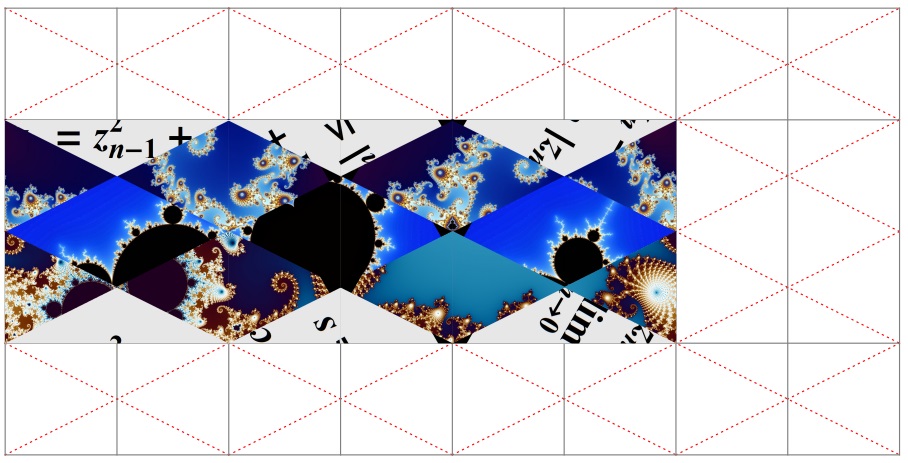Many years later, as watching Arvind Gupta folding a 3-D flexagon, I was to remember that distant day when my father brought me a cube that I was to know it is called Yoshimoto Cube.
This 3-D flexagon is very easy to be flexed to reveal hidden faces. Let’s make one, with the help of Mathematica.
The empty template:
Graphics[{ {Gray, Dotted,
{
With[{x1 = Max[0, #], y1 = Max[0, Quotient[-#, 2]]},
Line[{ {x1, y1}, {Min[# + 8, 8],
Quotient[Min[# + 8, 8] - x1, 2] + y1}}]],
With[{x1 = Max[0, #], y1 = 4 + Quotient[Min[#, 0], 2]},
Line[{ {x1, y1}, {Min[# + 8, 8],
y1 - Quotient[Min[# + 8, 8] - x1, 2]}}]]
} & /@ Range[-6, 6, 2]
},
Gray,
Line[{ {#, 0}, {#, 4} }] & /@ Range[0, 8],
Line[{ {0, #}, {8, #} }] & /@ {0, 1, 3, 4}}]

Drawing is a mission impossible to me. So I have to rotate and mask then translate pictures to fill them into these triangles. A face composed of 6 (or 12) triangles is not a plane, but I just rotate a picture by times of pi/3 rad, so overlap occurs on borders.
trianglesA = {Quotient[# + 1, 2] 2 \[Pi]/3,
If[EvenQ@#, Polygon[{{0, 0}, {1, 1/2}, {0, 1}}],
Polygon[{{0, 0}, { -1, 1/2}, {0, 1}}]],
{0 + Quotient[# + 1, 2] 2, 1}} & /@ Range[0, 5];
trianglesB = {Quotient[#, 2] 2 \[Pi]/3,
If[OddQ@#, Polygon[{{0, 0}, {1, 1/2}, {0, 1}}],
Polygon[{{0, 0}, { -1, 1/2}, {0, 1}}]],
{1 + Quotient[#, 2] 2, 3/2}} & /@ Range[0, 5];
trianglesC = {Quotient[# + 1, 2] 2 \[Pi]/3,
If[EvenQ@#, Polygon[{{0, 0}, {1, 1/2}, {0, 1}}],
Polygon[{{0, 0}, { -1, 1/2}, {0, 1}}]],
{0 + Quotient[# + 1, 2] 2, 2}} & /@ Range[0, 5];
trianglesD1 = {Quotient[#, 2] 2 \[Pi]/3,
If[OddQ@#, Polygon[{{0, 0}, {1, 1/2}, {0, 1/2}}],
Polygon[{{0, 0}, { -1, 1/2}, {0, 1/2}}]],
{1 + Quotient[#, 2] 2, 5/2}} & /@ Range[0, 5];
trianglesD2 = {Quotient[#, 2] 2 \[Pi]/3,
If[OddQ@#, Polygon[{{0, 1/2}, {1, 1/2}, {0, 1}}],
Polygon[{{0, 1/2}, { -1, 1/2}, {0, 1}}]],
{1 + Quotient[#, 2] 2, 1/2}} & /@ Range[0, 5];
trianglesD = trianglesD1~Join~trianglesD2;
$MAXSIZE = 500; (* HD not prefered *)
makeBraid[pic_, triangles_] := Module[
{size, newpic, masks, braid},
size = Max@ImageDimensions[pic];
newpic = ImageCrop[pic, {size, size}];
size = Min[size, $MAXSIZE];
newpic = ImageResize[newpic, size];
masks = {#[[1]],
Rasterize[
Graphics[{White, EdgeForm[White], #[[2]]},
Background -> Black, PlotRange -> {{ -1, 1}, { -1, 1}}],
ImageSize -> size], #[[3]]} & /@ triangles;
braid = {SetAlphaChannel[
ImageRotate[newpic, #[[1]], Full], #[[2]]], #[[3]]} & /@ masks;
Inset[#[[1]], #[[2]], Automatic, {2, 2}] & /@ braid
];
makeIt[pics_List] := Module[
{primitives},
primitives =
MapThread[
makeBraid, {
pics, {trianglesA, trianglesB, trianglesC, trianglesD}}];
Graphics[{
primitives,
{Red, Dotted,
{
With[{x1 = Max[0, #], y1 = Max[0, Quotient[-#, 2]]},
Line[{{x1, y1}, {Min[# + 8, 8],
Quotient[Min[# + 8, 8] - x1, 2] + y1}}]],
With[{x1 = Max[0, #], y1 = 4 + Quotient[Min[#, 0], 2]},
Line[{{x1, y1}, {Min[# + 8, 8],
y1 - Quotient[Min[# + 8, 8] - x1, 2]}}]]
} & /@ Range[-6, 6, 2]
},
Gray,
Line[{{#, 0}, {#, 4}}] & /@ Range[0, 8],
Line[{{0, #}, {8, #}}] & /@ {0, 1, 3, 4}},
PlotRange -> {{0, 7.9}, { -0.1, 4.1}}]
];Here is a not-so-awesome example:
